Corona−Poled Porous Electrospun Films of Gram−Scale Y−Doped ZnO and PVDF Composites for Piezoelectric Nanogenerators
Abstract
:1. Introduction
2. Experimental Section
2.1. Materials
2.2. Synthesis of Y−ZnO and ZnO
2.3. Fabrication of PVDF/Y−ZnO and PVDF/ZnO Porous Electrospun Film
2.4. Fabrication of PENGs
2.5. Characterization
3. Result and Discussion
3.1. Morphology, Molecular Structure, and Piezoelectric Performance of PVDF Porous Electrospun Films
3.2. Morphology, Molecular Structure, and Piezoelectric Performance of PVDF/Y−ZnO Porous Electrospun Films
4. Conclusions
Author Contributions
Funding
Institutional Review Board Statement
Data Availability Statement
Conflicts of Interest
References
- Azimi, S.; Golabchi, A.; Nekookar, A.; Rabbani, S.; Amiri, M.H.; Asadi, K.; Abolhasani, M.M. Self−powered cardiac pacemaker by piezoelectric polymer nanogenerator implant. Nano Energy 2021, 83, 105781. [Google Scholar] [CrossRef]
- Zhao, L.C.; Zou, H.X.; Zhao, Y.J.; Wu, Z.Y.; Liu, F.R.; Wei, K.X.; Zhang, W.M. Hybrid energy harvesting for self−powered rotor condition monitoring using maximal utilization strategy in structural space and operation process. Appl. Energy 2022, 314, 118983. [Google Scholar] [CrossRef]
- Zhao, L.-C.; Zou, H.-X.; Wu, Z.-Y.; Gao, Q.-H.; Yan, G.; Liu, F.-R.; Wei, K.-X.; Zhang, W.-M. Dynamically synergistic regulation mechanism for rotation energy harvesting. Mech. Syst. Signal Process. 2022, 169, 108637. [Google Scholar] [CrossRef]
- Ghosh, S.K.; Mandal, D. Synergistically enhanced piezoelectric output in highly aligned 1D polymer nanofibers integrated all−fiber nanogenerator for wearable nano−tactile sensor. Nano Energy 2018, 53, 245–257. [Google Scholar] [CrossRef]
- Zhou, Z.; Du, X.; Luo, J.; Yao, L.; Zhang, Z.; Yang, H.; Zhang, Q. Coupling of interface effects and porous microstructures in translucent piezoelectric composites for enhanced energy harvesting and sensing. Nano Energy 2021, 84, 105895. [Google Scholar] [CrossRef]
- Luo, J.T.; Yang, Y.C.; Zhu, X.Y.; Chen, G.; Zeng, F.; Pan, F. Enhanced electromechanical response of Fe−doped ZnO films by modulating the chemical state and ionic size of the Fe dopant. Phys. Rev. B 2010, 82, 014116. [Google Scholar] [CrossRef]
- Sahoo, R.; Mishra, S.; Ramadoss, A.; Mohanty, S.; Mahapatra, S.; Nayak, S.K. An approach towards the fabrication of energy harvesting device using Ca−doped ZnO/ PVDF−TrFE composite film. Polymer 2020, 205, 122869. [Google Scholar] [CrossRef]
- Sinha, N.; Goel, S.; Joseph, A.J.; Yadav, H.; Batra, K.; Gupta, M.K.; Kumar, B. Y−doped ZnO nanosheets: Gigantic piezoelectric response for an ultra sensitive flexible piezoelectric nanogenerator. Ceram. Int. 2018, 44, 8582–8590. [Google Scholar] [CrossRef]
- Yi, J.; Song, Y.; Cao, Z.; Li, C.; Xiong, C. Gram−scale Y−doped ZnO and PVDF electrospun film for piezoelectric nanogenerators. Compos. Sci. Technol. 2021, 215, 109011. [Google Scholar] [CrossRef]
- Hu, P.H.; Yan, L.L.; Zhao, C.X.; Zhang, Y.Y.; Niu, J. Double−layer structured PVDF nanocomposite film designed for flexible nanogenerator exhibiting enhanced piezoelectric output and mechanical property. Compos. Sci. Technol. 2018, 168, 327–335. [Google Scholar] [CrossRef]
- Muhterem, K.; Levent, P.; Osman, Ş. Fabrication and vibrational energy harvesting characterization of flexible piezoelectric nanogenerator (PEN) based on PVDF/PZT. Polym. Test 2020, 90, 106695. [Google Scholar] [CrossRef]
- Sabry, R.S.; Hussein, A.D. PVDF: ZnO/BaTiO3 as high out−put piezoelectric nanogenerator. Polym. Test 2019, 79, 106001. [Google Scholar] [CrossRef]
- Liu, B.; Han, L.; Pan, L.; Li, H.; Zhao, J.; Dong, Y.; Wang, X. Flexible Multiscale Pore Hybrid Self−Powered Sensor for Heart Sound Detection. Sensors 2021, 21, 4508. [Google Scholar] [CrossRef] [PubMed]
- Lewis, R.W.C.; Dent, A.C.E.; Stevens, R.; Bowen, C.R. Microstructural modelling of the polarization and properties of porous ferroelectrics. Smart Mater. Struct. 2011, 20, 085002. [Google Scholar] [CrossRef]
- Gomes, J.; Serrado Nunes, J.; Sencadas, V.; Lanceros-Mendez, S. Influence of the β-phase content and degree of crystallinity on the piezo- and ferroelectric properties of poly(vinylidene fluoride). Smart Mater. Struct. 2010, 19, 065010. [Google Scholar] [CrossRef]
- Ting, Y.; Suprapto; Chiu, C.−W.; Gunawan, H. Characteristic analysis of biaxially stretched PVDF thin films. J. Appl. Polym. Sci. 2018, 135, 46677. [Google Scholar] [CrossRef]
- Zaarour, B.; Zhu, L.; Huang, C.; Jin, X. Enhanced piezoelectric properties of randomly oriented and aligned electrospun PVDF fibers by regulating the surface morphology. J. Appl. Polym. Sci. 2019, 136, 47049. [Google Scholar] [CrossRef]
- Sultana, A.; Alam, M.M.; Ghosh, S.K.; Middya, T.R.; Mandal, D. Energy harvesting and self−powered microphone application on multifunctional inorganic−organic hybrid nanogenerator. Energy 2019, 166, 963–971. [Google Scholar] [CrossRef]
- Lu, L.J.; Yang, B.; Zhai, Y.Q.; Liu, J.Q. Electrospinning core−sheath piezoelectric microfibers for self−powered stitchable sensor. Nano Energy 2020, 76, 104966. [Google Scholar] [CrossRef]
- Jang, S.; Kim, Y.; Lee, S.; Oh, J.H. Optimization of Electrospinning Parameters for Electrospun Nanofiber−Based Triboelectric Nanogenerators. Int. J. Precis. Eng. Manuf. Technol. 2019, 6, 731–739. [Google Scholar] [CrossRef]
- Yousry, Y.M.; Yao, K.; Chen, S.T.; Liew, W.H.; Ramakrishna, S. Mechanisms for Enhancing Polarization Orientation and Piezoelectric Parameters of PVDF Nanofibers. Adv. Electron. Mater. 2018, 4, 1700562–1700569. [Google Scholar] [CrossRef]
- Qiu, X. Patterned piezo−, pyro−, and ferroelectricity of poled polymer electrets. J. Appl. Phys. 2010, 108, 011101. [Google Scholar] [CrossRef]
- Tong, W.; An, Q.; Wang, Z.; Li, Y.; Tong, Q.; Li, H.; Zhang, Y.; Zhang, Y. Enhanced Electricity Generation and Tunable Preservation in Porous Polymeric Materials via Coupled Piezoelectric and Dielectric Processes. Adv. Mater. 2020, 32, e2003087. [Google Scholar] [CrossRef]
- Adhikary, P.; Garain, S.; Mandal, D. The co−operative performance of a hydrated salt assisted sponge like P(VDF−HFP) piezoelectric generator: An effective piezoelectric based energy harvester. Phys. Chem. Chem. Phys. 2015, 17, 7275–7281. [Google Scholar] [CrossRef] [PubMed]
- Wang, S.; Zhang, L.; Wang, L.; He, Y.; Wu, M. Fluorinated Barium Titanate Nanoparticles for Wearable Piezoelectric Power Generation. ACS Appl. Nano Mater. 2022, 5, 3352–3360. [Google Scholar] [CrossRef]
- Li, Y.; Xu, M.H.; Xia, Y.S.; Wu, J.M.; Sun, X.K.; Wang, S.; Hu, G.H.; Xiong, C.X. Multilayer assembly of electrospun/electrosprayed PVDF-based nanofibers and beads with enhanced piezoelectricity and high sensitivity. Chem. Eng. J. 2020, 388, 124205. [Google Scholar] [CrossRef]
- Song, Y.; Bao, J.; Hu, Y.; Cai, H.; Xiong, C.; Yang, Q.; Tian, H.; Shi, Z. Forward polarization enhanced all-polymer based sustainable triboelectric nanogenerator from oriented electrospinning PVDF/cellulose nanofibers for energy harvesting. Sustain. Energy Fuels 2022, 6, 2377–2386. [Google Scholar] [CrossRef]
- Zhang, J.W.; Lebrun, L.; Guiffard, B.; Belouadah, R.; Guyomar, D.; Garbuio, L.; Cottinet, P.J.; Liu, Q. Enhanced electromechanical performance of cellular polypropylene electrets charged at a high temperature. J. Phys. D Appl. Phys. 2011, 44, 415403. [Google Scholar] [CrossRef]
- Maity, K.; Garain, S.; Henkel, K.; Schmeisser, D.; Mandal, D. Natural Sugar−Assisted, Chemically Reinforced, Highly Durable Piezoorganic Nanogenerator with Superior Power Density for Self−Powered Wearable Electronics. ACS Appl. Mater. Interfaces 2018, 10, 44018–44032. [Google Scholar] [CrossRef]
- Guo, W.; Tan, C.; Shi, K.; Li, J.; Wang, X.X.; Sun, B.; Huang, X.; Long, Y.Z.; Jiang, P. Wireless piezoelectric devices based on electrospun PVDF/BaTiO3 NW nanocomposite fibers for human motion monitoring. Nanoscale 2018, 10, 17751–17760. [Google Scholar] [CrossRef]
- Soheil, M.; Tahereh Fanaei, S.; Amin, B. Investigation on the electrospun PVDF/NP−ZnO nanofibers for application in environmental energy harvesting. J. Mater. Res. Technol. 2018, 8, 1608–1615. [Google Scholar] [CrossRef]
- Tusiime, R.; Zabihi, F.; Tebyetekerwa, M.; Yousry, Y.M.; Wu, Y.; Eslamian, M.; Yang, S.; Ramakrishna, S.; Yu, M.; Zhang, H. High stress−driven voltages in net−like layer−supported organic–inorganic perovskites. J. Mater. Chem. C 2020, 8, 2643–2658. [Google Scholar] [CrossRef]
- Chen, C.; Bai, Z.K.; Cao, Y.Z.; Dong, M.C.; Jiang, K.K.; Zhou, Y.S.; Tao, Y.Z.; Gu, S.J.; Xu, J.; Yin, X.Z.; et al. Enhanced piezoelectric performance of BiCl3/PVDF nanofibers−based nanogenerators. Compos. Sci. Technol. 2020, 192, 108100. [Google Scholar] [CrossRef]
- Sun, Y.; Liu, Y.; Zheng, Y.; Li, Z.; Fan, J.; Wang, L.; Liu, X.; Liu, J.; Shou, W. Enhanced Energy Harvesting Ability of ZnO/PAN Hybrid Piezoelectric Nanogenerators. ACS Appl. Mater. Interfaces 2020, 12, 54936–54945. [Google Scholar] [CrossRef] [PubMed]
- Yang, L.; Zhao, Q.; Chen, K.; Ma, Y.; Wu, Y.; Ji, H.; Qiu, J. PVDF−Based Composition−Gradient Multilayered Nanocomposites for Flexible High−Performance Piezoelectric Nanogenerators. ACS Appl. Mater. Interfaces 2020, 12, 11045–11054. [Google Scholar] [CrossRef] [PubMed]
- Guan, X.Y.; Xu, B.G.; Gong, J.L. Hierarchically architected polydopamine modified BaTiO3@P(VDF−TrFE) nanocomposite fiber mats for flexible piezoelectric nanogenerators and self−powered sensors. Nano Energy 2020, 70, 104516–104528. [Google Scholar] [CrossRef]
- Mohammed, K.; Arunjunairaj, M.; Srinivasan, A. Durable, efficient, and flexible piezoelectric nanogenerator from electrospun PANi/HNT/PVDF blend nanocomposite. Polym. Compos. 2018, 40, 1663–1675. [Google Scholar] [CrossRef]
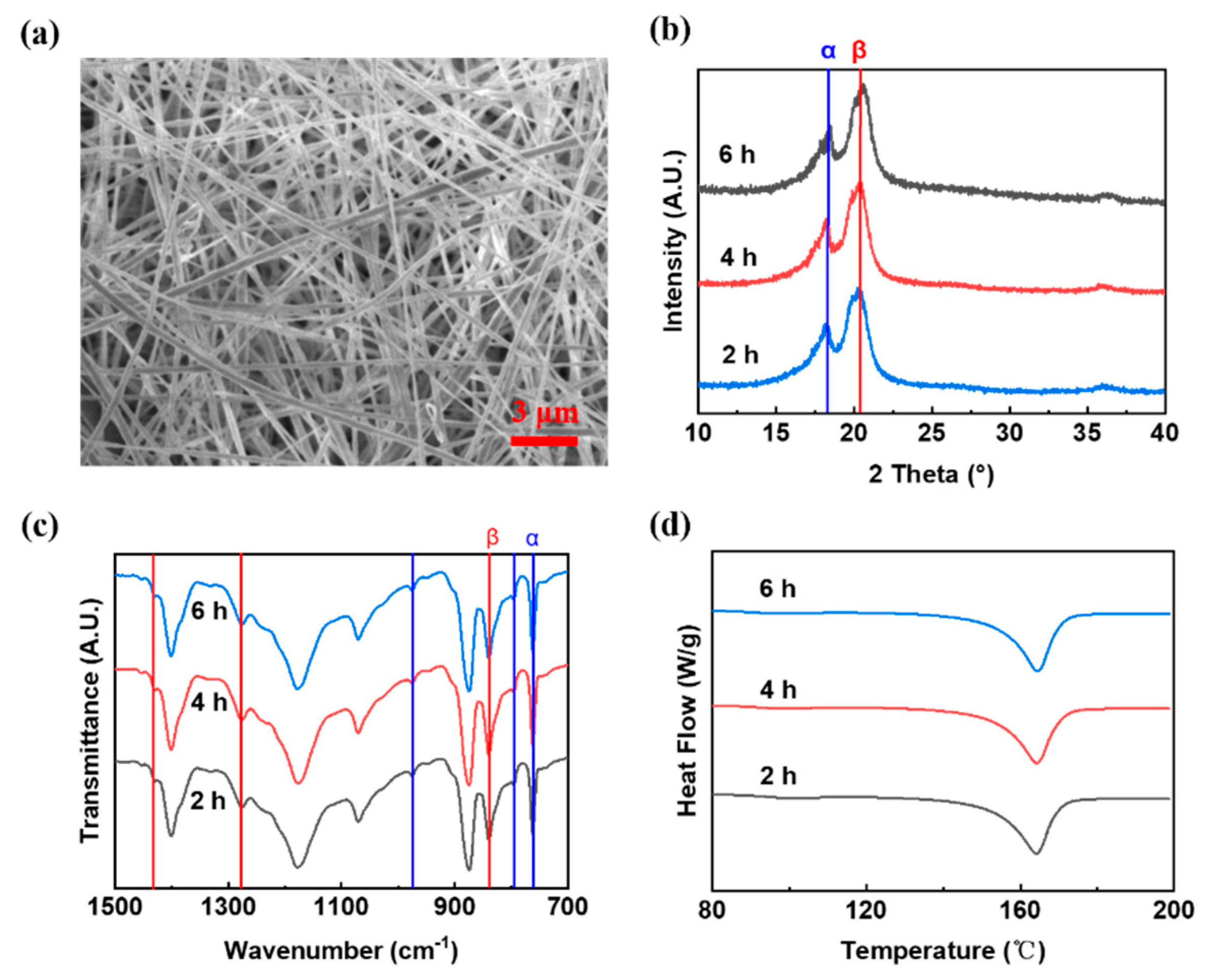
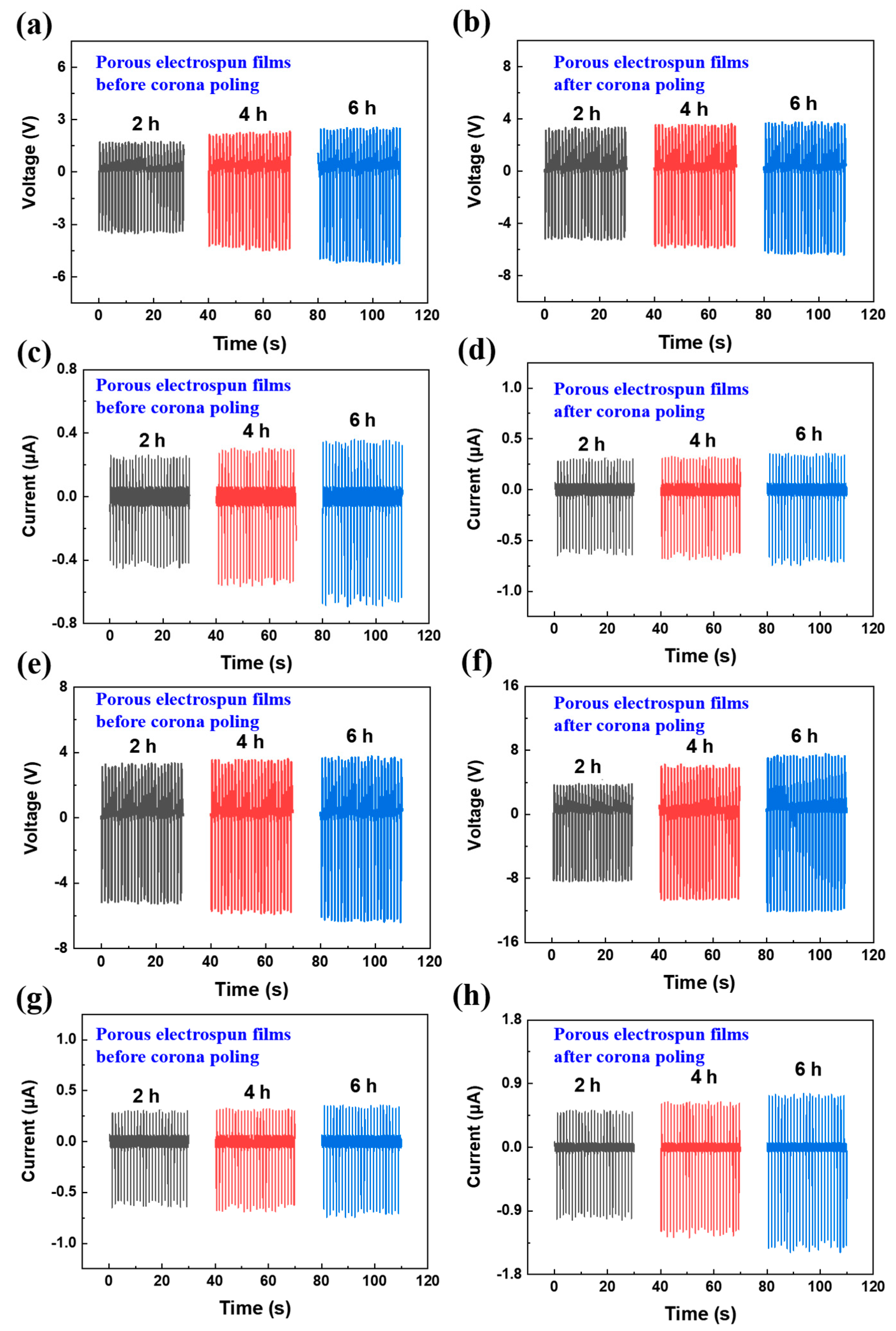
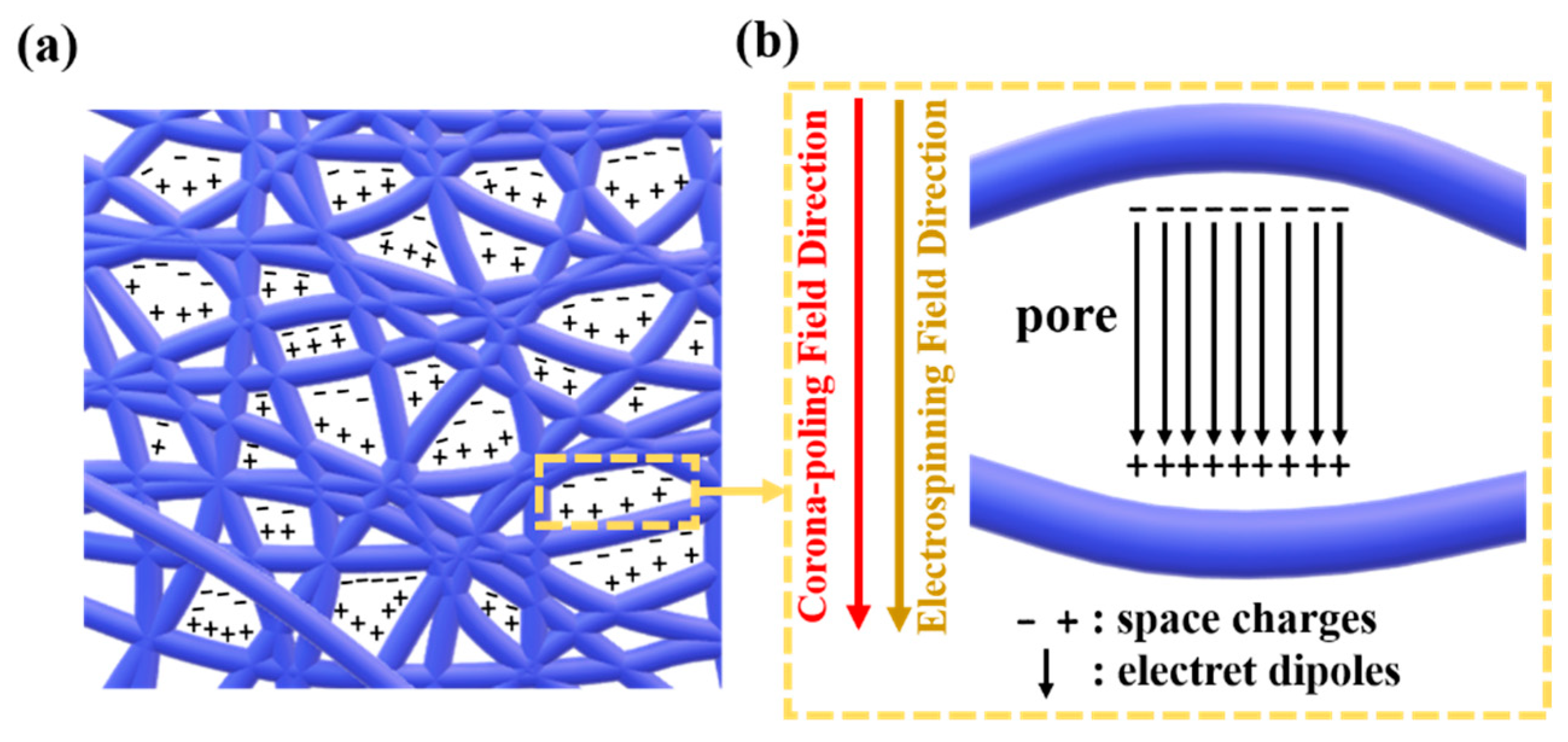
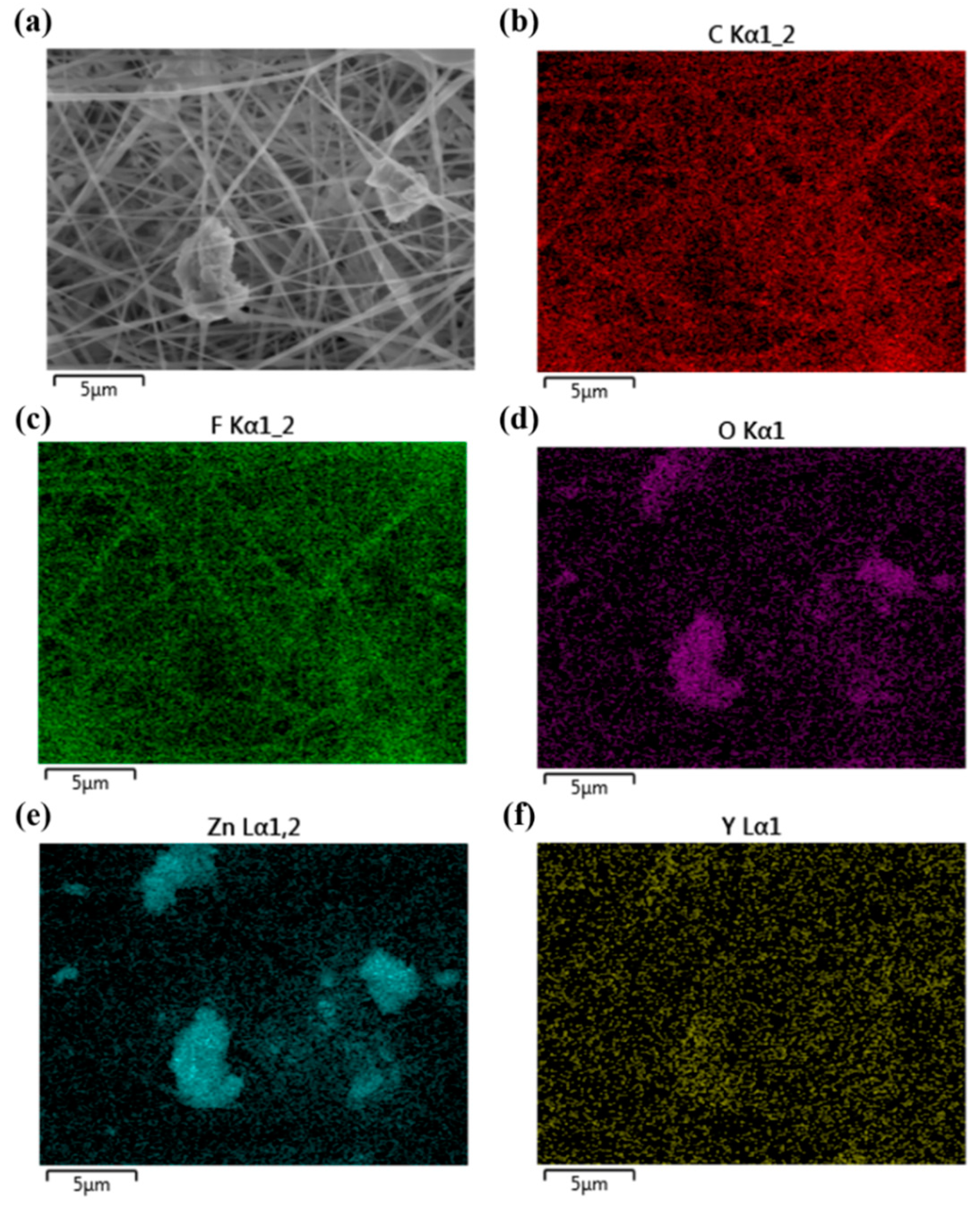



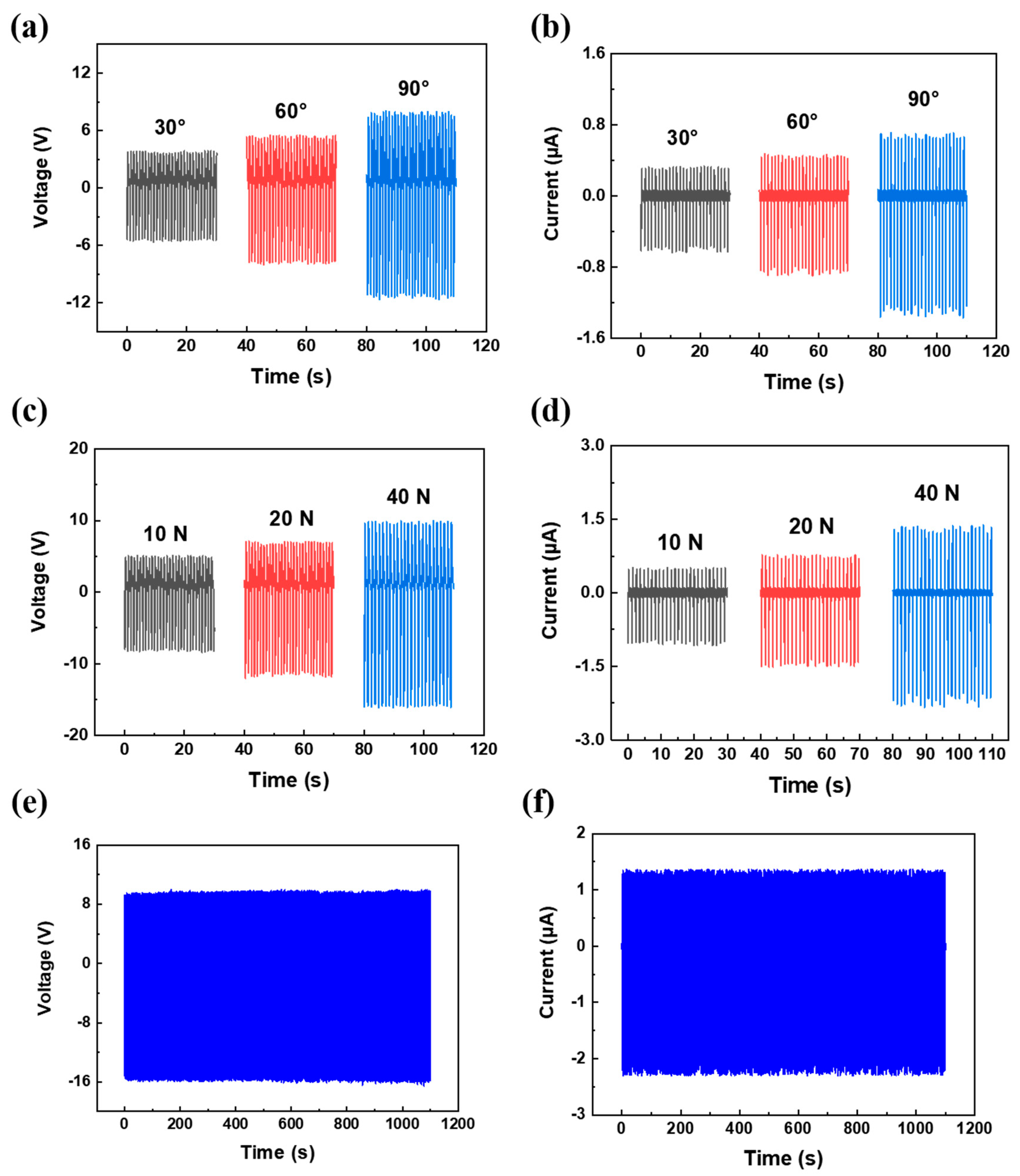
| Devices | Type | Area (cm2) | Force | Average Power Density | Ref. |
|---|---|---|---|---|---|
| PVDF−HFP/ MgCl2·6H2O | sponge−like | 6.3 | finger touch | 60 nW | [24] |
| PVDF/ZnO | electrospun | 1 | 1.5 N | 0.032 μW/cm2 | [31] |
| PVDF/PLA/ SnO2/MAPbI3 | unpoled; spin−coated | 0.0625 | bending | ~143 nW | [32] |
| PVDF/BiCl3 | electrospun | 2.25 | 150 g mass block | 0.2 μW/cm2 | [33] |
| PAN/ZnO | electrospun | 16 | 8 N | 1.08 μW/cm2 | [34] |
| PVDF/3D−CNTs | electrospun | 16 | − | 72 mW/cm3 | [35] |
| P(VDF−TrFE)/ BTO | electrospun | 6.25 | 700 N | ~0.878 μW/cm2 | [36] |
| PVDF/PANi/HNT | electrospun | 5.1 | 14 g mass block | ~0.049 μW/cm2 | [37] |
| PVDF/ Y−ZnO | dense; corona−poled | 4 | 40 N | 3.6 μW/cm2 | This work |
Publisher’s Note: MDPI stays neutral with regard to jurisdictional claims in published maps and institutional affiliations. |
© 2022 by the authors. Licensee MDPI, Basel, Switzerland. This article is an open access article distributed under the terms and conditions of the Creative Commons Attribution (CC BY) license (https://creativecommons.org/licenses/by/4.0/).
Share and Cite
Yi, J.; Song, Y.; Zhang, S.; Cao, Z.; Li, C.; Xiong, C. Corona−Poled Porous Electrospun Films of Gram−Scale Y−Doped ZnO and PVDF Composites for Piezoelectric Nanogenerators. Polymers 2022, 14, 3912. https://doi.org/10.3390/polym14183912
Yi J, Song Y, Zhang S, Cao Z, Li C, Xiong C. Corona−Poled Porous Electrospun Films of Gram−Scale Y−Doped ZnO and PVDF Composites for Piezoelectric Nanogenerators. Polymers. 2022; 14(18):3912. https://doi.org/10.3390/polym14183912
Chicago/Turabian StyleYi, Juan, Yiheng Song, Shixian Zhang, Zhilong Cao, Chenjian Li, and Chuanxi Xiong. 2022. "Corona−Poled Porous Electrospun Films of Gram−Scale Y−Doped ZnO and PVDF Composites for Piezoelectric Nanogenerators" Polymers 14, no. 18: 3912. https://doi.org/10.3390/polym14183912




